Ingredients
Brongkos consists of diced meat, either beef, goat meat, or mutton; a hard-boiled egg and tofu; stewed beans, usually black-eyed peas or red kidney beans; diced chayote; and sometimes carrots.
The coconut milk-based stews use a rich mixture of spices, which includes black kluwek , bruised lemongrass, kaffir lime leaves, bay leaves, salt, palm sugar, spice paste consists of ground galangal, kencur , ginger, coriander, shallot and roasted candlenut, also a whole of bird's eye chilies which add a surprising hot spiciness when bitten. [2]
Brongkos often served together with steamed rice in a single plate as nasi brongkos (lit. "brongkos rice").

Satay, or sate in Indonesian and Malay spelling, is a Southeast Asian dish of seasoned, skewered and grilled meat, served with a sauce. The earliest preparations of satay originated in Javanese cuisine, but has spread to almost anywhere in Indonesia, where it has become a national dish. Indonesian satay is often served with peanut sauce and kecap manis – a sweet soy sauce, and is often accompanied with ketupat or lontong, a type of rice cake, though the diversity of the country has produced a wide variety of satay recipes. It is also popular in many other Southeast Asian countries including Brunei, Malaysia, Philippines, Singapore and Thailand. It also recognized and popular in Suriname and the Netherlands. In Sri Lanka, it has become a staple of the local diet as a result of the influences from the local Malay community.

Indonesian cuisine is a collection of various regional culinary traditions that formed in the archipelagic nation of Indonesia. There are a wide variety of recipes and cuisines in part because Indonesia is composed of approximately 6,000 populated islands of the total 17,508 in the world's largest archipelago, with more than 1,300 ethnic groups.

Gudeg is a traditional Javanese dish from Yogyakarta, in Central Java, Indonesia. Gudeg is made from young, unripe jackfruit stewed for several hours with palm sugar and coconut milk. Additional spices include garlic, shallot, candlenut, coriander seed, galangal, bay leaves, and teak leaves, the latter gives a reddish-brown color to the dish. It is often described as "green jack fruit sweet stew".
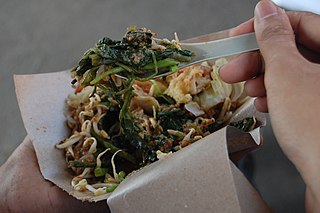
Pecel is a traditional Javanese salad with peanut sauce, usually eaten with carbs.

Kue is an Indonesian bite-sized snack or dessert food. Kue is a fairly broad term in Indonesian to describe a wide variety of snacks including cakes, cookies, fritters, pies, scones, and patisserie. Kue are made from a variety of ingredients in various forms; some are steamed, fried or baked. They are popular snacks in Indonesia, which has the largest variety of kue. Because of the countries' historical colonial ties, Koeé (kue) is also popular in the Netherlands.
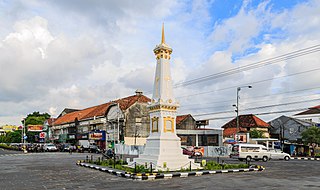
Yogyakarta is the capital city of the Special Region of Yogyakarta in Indonesia, in the south-central part of the island of Java. As the only Indonesian royal city still ruled by a monarchy, Yogyakarta is regarded as an important centre for classical Javanese fine arts and culture such as ballet, batik textiles, drama, literature, music, poetry, silversmithing, visual arts, and wayang puppetry. Renowned as a centre of Indonesian education, Yogyakarta is home to a large student population and dozens of schools and universities, including Gadjah Mada University, the country's largest institute of higher education and one of its most prestigious.
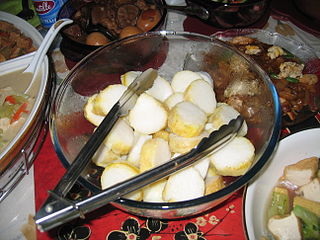
Lontong is an Indonesian dish made of compressed rice cake in the form of a cylinder wrapped inside a banana leaf, commonly found in Indonesia, Malaysia, and Singapore. Rice is rolled inside a banana leaf and boiled, then cut into small cakes as a staple food replacement for steamed rice. The texture is similar to that of ketupat, with the difference being that the ketupat container is made from woven janur fronds, while lontong uses banana leaf instead.

Javanese cuisine is the cuisine of Javanese people, a major ethnic group in Indonesia, more precisely the province of Central Java, Yogyakarta and East Java.

Kopi Tubruk is an Indonesian-style coffee where hot water is poured over fine coffee grounds directly in the glass, without any filtration, usually with added sugar.
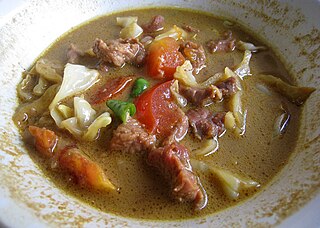
Tongseng is an Indonesian goat meat, mutton or beef stew dish in curry-like soup, with vegetables and kecap manis. Tongseng is commonly found in the Indonesian region of Central Java; from Surakarta to Yogyakarta. However, it is believed that the dish originated from Klego district in Boyolali, Central Java.
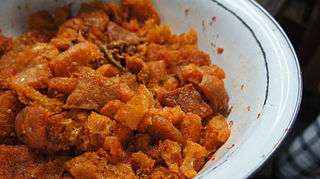
Krechek or krecek or sambal goreng krechek is a traditional Javanese cattle skin spicy stew dish from Yogyakarta and Central Java, Indonesia. Traditionally it is made from the soft inner skin of cattle, however, the most common recipe today uses readily available rambak or krupuk kulit.

Soto is a traditional Indonesian soup mainly composed of broth, meat, and vegetables. Many traditional soups are called soto, whereas foreign and Western influenced soups are called sop.
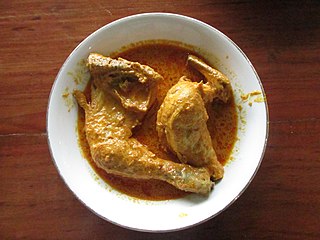
Gulai is a class of spicy and rich stew commonly found in the Malay Archipelago. The main ingredients of the dish are usually poultry, goat meat, beef, mutton, various kinds of offal, fish, and seafood, as well as vegetables such as cassava leaves, unripe jackfruit, and banana stem.
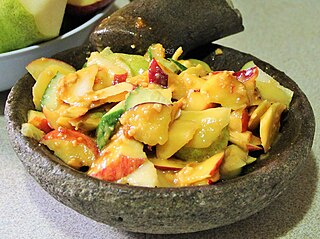
Rujak or rojak is a salad dish of Javanese origin, commonly found in Indonesia, Malaysia and Singapore. The most popular variant in all three countries is a salad composed of a mixture of sliced fruit and vegetables served with a spicy palm sugar dressing. It is often described as tangy and spicy fruit salad due to its sweet, hot and spicy dressing made from ground chilli, palm sugar and peanuts.
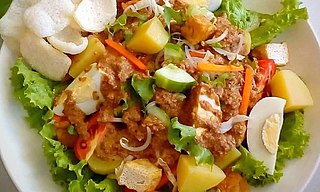
Gado-gado is an Indonesian salad of raw, slightly boiled, blanched or steamed vegetables and hard-boiled eggs, boiled potato, fried tofu and tempeh, and sliced lontong, served with a peanut sauce dressing.

Ayam geprek is an Indonesian crispy battered fried chicken crushed and mixed with hot and spicy sambal. Currently ayam geprek is commonly found in Indonesia and neighbouring countries, however its origin was from Yogyakarta in Java.

Nasi tutug oncom or sometimes simply called tutug oncom, is an Indonesian style rice dish, made of rice mixed with oncom fermented beans, originally from Tasikmalaya, West Java. It is usually wrapped in banana leaves and served with various side dishes.
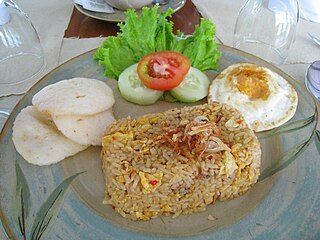
Nasi goreng jawa is a Javanese-style of fried rice originated from Java, Indonesia. This dish can be found in Javanese cuisine and quite popular in Indonesia, especially Java. Commonly, this rice dish uses sambal ulek as seasoning and has a spicy taste.

Nasi gandul or in Javanese sega gandhul is a rice dish served in rich, sweet, savoury and spicy beef soup, specialty of Pati Regency, Central Java, Indonesia. Nasi gandul consists of steamed rice topped with slices of beef served in spicy soup with savoury flavour in golden-brownish colour. Nasi gandul is somewhat quite similar to other Indonesian dishes; beef semur, tongseng and Javanese gulai.




















